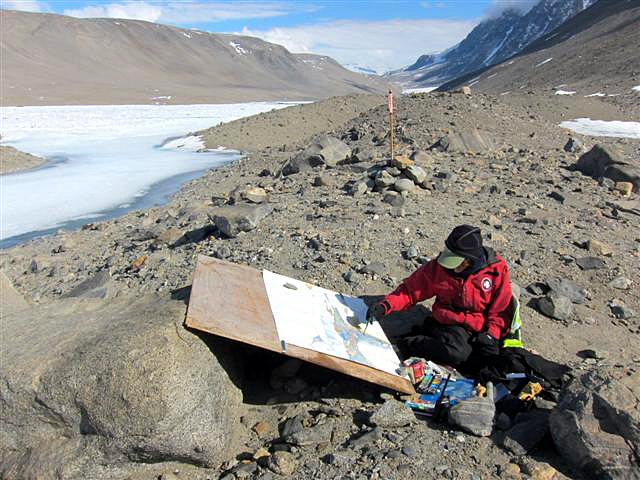Drawing AntarcticaEngler documents life on the continent through unique artistic stylePosted July 30, 2010
Many of the artists, writers and photographers who venture down to Antarctica are usually trying to capture some element of what life is like on the Ice or something about the ongoing research into the unique polar environment. Elise Engler The New York City-based visual artist has what seems to be an almost obsessive need to draw every object in a given place or situation. Her works are like hieroglyphic scrolls that tell a rich story through the ordinary objects of life. Her style first emerged when she decided to draw every object that she owned, a daunting 18-month task that ended with 13,127 drawings. “I started to draw it all, item by item, from room to room. I didn’t tell anybody that I was doing it because I thought they might want to commit me,” she confides. She went on to projects that ranged from drawing the contents of containers such as women’s handbags to drawing everything found on the desks of power-suited venture capitalists. Her work has taken her to a 15th century castle in Italy and the Pacific Northwest aboard a research vessel. In each instance, Engler has used her colored pencils to create a sort of pictographic text on reams of paper. Each object, drawn roughly to the same size, floats against a white background in row after row. “It is a type of text,” she explains. “And it reads as text very often.” But a nearly two-month trip to McMurdo Station “It’s really changed my life in a lot of ways,” Engler stresses, several months after returning to New York, in the midst of the worst heat wave of the summer. It’s not just the cool weather that she misses about the Ice, however. The trip, made during the height of the summer season in Antarctica, sent her to various field camps near McMurdo, the logistics hub of the U.S. Antarctic Program The weather, while cold, was workable and not what she expected — like much of Antarctica. “Expectations get erased by experience,” she says. “I had all of these little bits and pieces of information that I had gleaned from film and reading. It sort of got wiped out by the radically different nature of life there.” But Engler adapted, beginning with drawings and paintings of the scenes from her lab-cum-art studio at McMurdo Station. “I worked from my immediate surroundings. That got me warmed up going forward.” The New Yorker moved to the field camps in the Dry Valleys and penguin rookeries. And then she did something that she rarely does. She painted landscapes. “The situation there just made we want to do landscapes,” she says. “The landscape was so spectacular in every direction that I started by make large gouache [opaque watercolor] landscapes.” Engler says she decided the pictograph text that serves as her artistic voice was inadequate to the task of telling the full story of Antarctica. “It didn’t allow me a way to incorporate the landscape. The landscape is so significant there. Just to make a list of objects seems like you’re just leaving out the essence of being there,” she says. Now, back in the studio, the gouache landscapes serve as the backdrop, the context, for the story, as Engler begins the task of drawing the objects from the field camps. She took hundreds of photos based on interviews with camp staff and scientists on what items are important for scientific fieldwork. For another project, what Engler describes as a journalistic piece, she has drawn a simple map of Antarctica surrounded by a turquoise sea. She then draws objects and scenes from her travels inside and around the continent. A final exhibit, tentatively titled “Unpacking Antarctica,” is still more than six months away. Engler also hopes to produce a book from the trip, and she says a magazine article is also in the works. “I know that anything I do in the future will be affected by this change in my work that started by going to Antarctica,” she says.
NSF-funded research in this story: Elise Engler, Antarctic Artists and Writers Program, Award No. 0840003
|



For USAP Participants |
For The Public |
For Researchers and EducatorsContact UsU.S. National Science FoundationOffice of Polar Programs Geosciences Directorate 2415 Eisenhower Avenue, Suite W7100 Alexandria, VA 22314 Sign up for the NSF Office of Polar Programs newsletter and events. Feedback Form |





